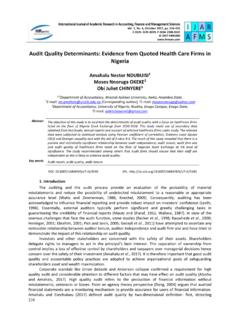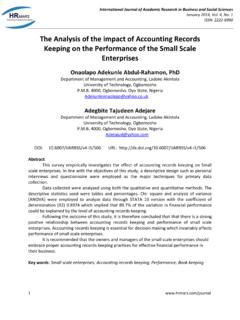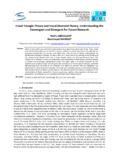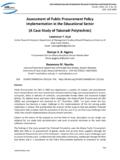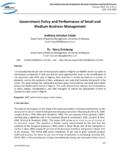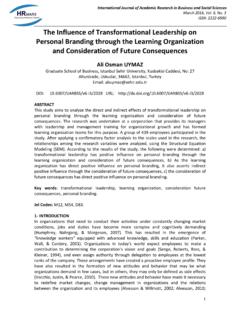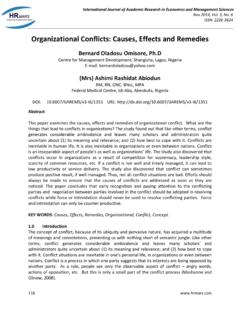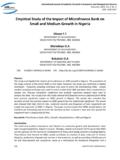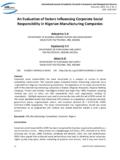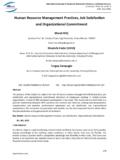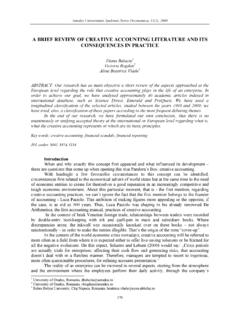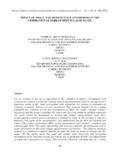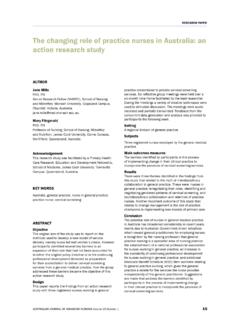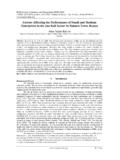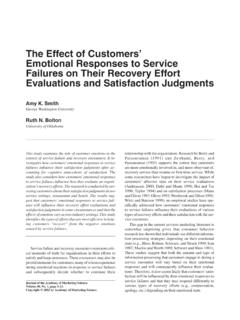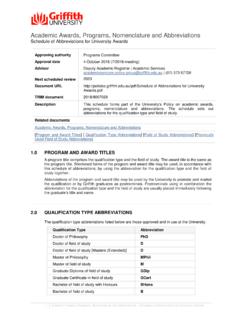Transcription of The Role of Micro-Finance Institutions to the Growth of ...
1 International Journal of Academic Research in accounting , finance and Management Sciences Vol. 4, , October 2014, pp. 249 262 E-ISSN: 2225-8329, P-ISSN: 2308-0337 2014 HRMARS The Role of Micro-Finance Institutions to the Growth of micro and Small Enterprises (MSE) in Thika, Kenya (Empirical Review of Non-Financial Factors) Paul Munene MUIRURI Department of Commerce and Economic Studies Jomo Kenyatta University of Agriculture and Technology Nairobi, Kenya, E-mail: Abstract micro and small enterprises (MSE) known as Jua Kali are the biggest employer in Kenya and accounts for 10 million and million of this number are in the informal sector. It also continues to employ more each year at an average rate of about two percent (ICPAK, 2010).
2 This research report present specific insights on the contribution of microfinance service to the Growth of MSEs in developing countries. The study sought to investigate the role of microfinance Institutions on Growth of micro and small enterprise (MSE) in Thika Municipality, Kenya. This was motivated by the need to fill-up the academic gap on contribution of microfinance services left by previous researchers. In order to achieve the study objective, a cross-sectional survey was carried that analyzed both secondary and primary data. Through random sampling technique, two hundred and eighty five MSEs and sixteen MFIs were selected. This included MSEs Owners and MFI managers, it represents percent of the total MSE Owners as of 2009 Thika Municipal record was considered representative and reliable for generalization.
3 Data collection was done using questionnaires and interview schedules to the different respondents. After the data was collected it was entered and cleaned before being analyzed using the statistical packages for social sciences software (SPSS windows version ). The findings are presented using both tabular and graphical presentation. Statistics in the study demonstrate that MFIs offer services to customers (MSEs) had contributed Growth which has been rapid over the years. Majority of businesses in Thika Municipality ( percent) were owned by married people. Default rate was high while MFI loan was second main source of capital ( ) contrary to Oketch (1995). The main reason for their saving was for expansion of and Growth of business the same sentiments echoed by Jagongo (2009).
4 Finally, percent business was initiated with capital less than ten thousand Kenyan shillings. This low seed capital explains why MSEs have stagnant Growth . Finally the businesses that received MFI services reported Growth in sale, revenue and number of employees employed. The study recommended that government should set policy regarded essential in improving loan repayment period and loan amount. From research it is clear that there exists a large unexploited saving mobilization and utilization potential. Key words Effects, Microfinance Institutions (MFI), micro and Small Enterprises (MSE), Growth , Non-Financial factors DOI: URL: 1. Introduction In Kenya, micro finance Institutions (MFI) was pioneered by Non-Governmental Organizations (NGOs) in collaboration with the government.
5 The government aided the development of micro finance International Journal of Academic Research in accounting , finance and Management Sciences Vol. 4 (4), pp. 249 262, 2014 HRMARS 250 Institutions (MFIs) by providing the policy framework and platform for donor support; these NGOs include World Bank, USAID ( Agency for International Development), UNDP (United Nations Development Programme) and later the commercial banks supported NGOs by financing the operations (Mutua, 2006). Despite the growing number of MFIs, their outreach is constrained, especially in rural areas, because of their limited resource base and lack of institutional capacity to provide a wide range of financial services (GOK, 2004, p. 16.). MFI outreach is predominantly through group-based programmes, which have limited absorptive capacity for financial resources.
6 Although commercial banks have a stronger resource base and wider outreach, they lack expertise in micro finance (MF) lending to the MSE sector. The focus of most MF lending is informal economy MSEs ( Jua Kali ), often women who are conducting trade in small goods or providing services (GOK, 2004). MSE Growth As regard vertical Growth studies indicate that many MSE donot generally grow as would be expected .They tend to remain within their original size categories (Kibas, 1995 and King, 1996). Specific cases studies have showed that 50% and 60% modern MSE in Asia and Latin America grew from low entrepreneur (Kibas, 1995). Gudda, 2003 cited that few enterprises grew naturally from micro to small and medium in Nigeria only and medium grew out of MSE.
7 The situation was found to be worst in Rwanda , Botswana However, empirical studies in East Africa are scanty, low rate of Growth MSE as result of micro finance services, in additional similarly several studies in Kenya has indicated same (Mwaniki, 2006). In India, the micro and Small Enterprises (MSEs) sector played a pivotal role in the overall industrial economy of the country. It was estimated that in terms of value, the sector accounts for about 39% of the manufacturing output and around 33% of the total export of the country (Graham, 2000). The MSE sector in Kenya has faced several constrains to Growth and development one being financial dues to limited access to credit facilities. A number of informal microfinance has come to rescue of MSE in access to credit (GOK, 2005).
8 It was estimated that this MSE sector Constitute 98% of all business in the country absorbing over 50% of all new non-farm employment seekers, contributing up to 30% of total employment and 3% of GDP (KIPPRA, 2002). The Growth of Kenya micro and small enterprises (MSEs) into Small business enterprises (SMEs) into big companies, with a turn over of one billion, is as low if not a disheartening statistics. Looking at Business daily and KPMG annual SMEs survey (top 100 SMEs) carried in 2008, only four companies graduated from SMEs class in 2009 survey by reaching one billion Mark; this represent four percent. Yet, the MSEs (Jua kali) are biggest employer in the country, accounting for 10 million and million of this number are in the informal sector Jua Kali.
9 It also continues to employ more each year at an average rate of about two percent .However Kenya government is slow to recognize this . However, the policy that would be seen as incentive to help grow MSEs (informal) to SMEs (formal) and then big companies is slowing coming (ICPAK, 2010). In Kenya, MSE continue to suffer the most poor business environment Said Kenya finance Minister Uhuru Kenyatta, during his National budget presentation on June 10, 2010. In the 1970s and early 1980s, these services were delivered through an integrated support programmes. Despite the growing number of MFIs, their outreach is constrained, especially in rural areas, because of their limited resource base and lack of institutional capacity to provide a wide range of financial services (GOK, 2004, p.)
10 16.). MFI outreach is predominantly through group-based programmes, which have limited absorptive capacity for financial resources. The focus of most MF lending is informal economy MSEs ( Jua Kali ), often women who are conducting trade in small goods or providing services (GOK, 2004, p. 24). Despite the significant role played by the MSE, it has contributed to experience many binding constraints that have inhibited it full potential these include poor access to market, financial services and unfavorable policy (Jagongo, 2009). The MSE face biggest constraints in accessing market, energy, transport, security, legal services and not least to investment finance . The biggest headache of all is still the lack or limited access of much needed credit to start or grow their businesses despite having created funds worth billion provided by Kenyan Government through Youth and women funds.
